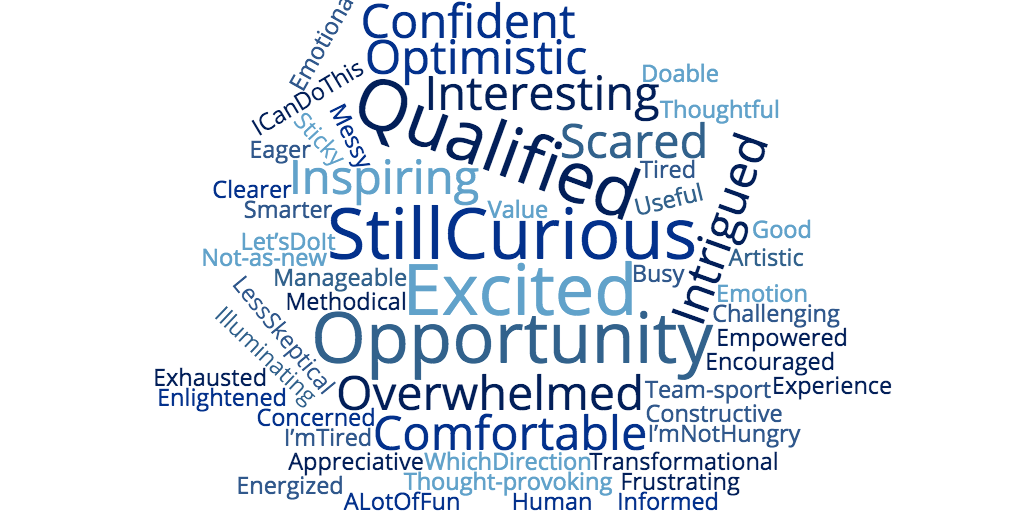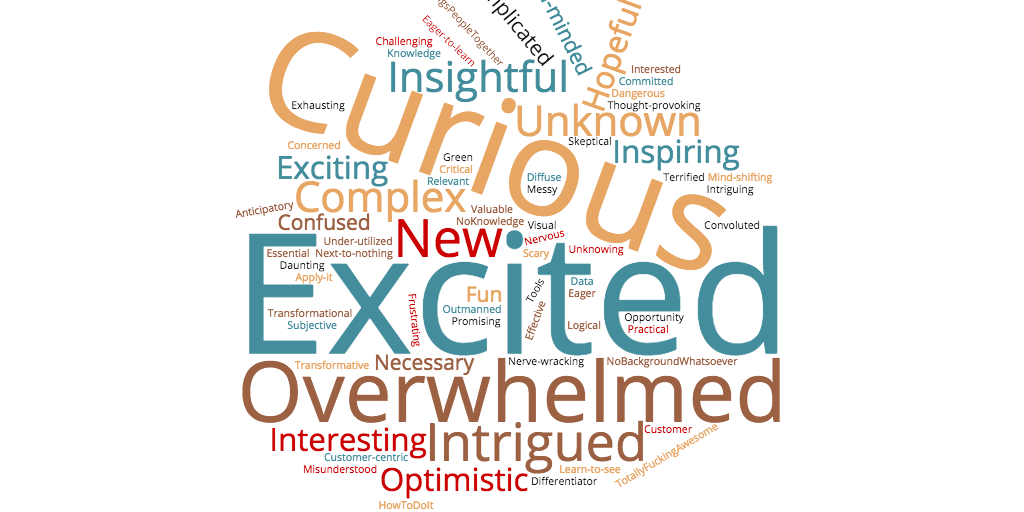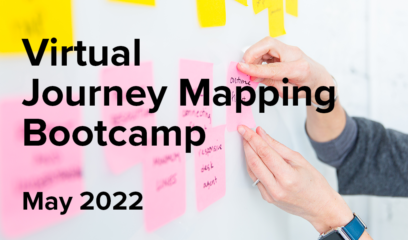Whenever we conduct one of our open enrollment journey mapping workshops, we start by asking attendees to list three words that describe their current feelings toward journey mapping. As you can see above, the top two responses are curious and excited. But overwhelmed is a close third.
Take a look at the smaller text, and you’ll see that a few attendees have bravely admitted that they see journey mapping as daunting. Challenging. Complicated. Messy. Even…dangerous. You might be surprised to hear that we agree with some of these sentiments. Committing to paper your hypotheses and assumptions about your customers’ experiences can, in fact, be dangerous. And it’s definitely messy—by the end of a typical customer workshop, our workshop room usually looks like the colorful aftermath of a sticky note tornado.
However, there’s no need to panic. The good news is that it’s normal to feel overwhelmed at the beginning of your organization’s journey mapping journey. The even better news is that there are several things you can do to minimize that feeling and gain confidence in your journey mapping skills. We recommend that you:
- Just start mapping. As with many things in life, the best way to combat journey mapping uncertainty and confusion is to learn by doing. Grab some of your colleagues, several packs of sticky notes, and a handful of Sharpie markers—and start by writing down all of the actions you believe your customers take as they try to accomplish their goals. (Each action goes on a separate sticky note.) Next, outline the physical, digital, and human touchpoints that you think they interact with. Finally, add in what you believe customers are thinking and feeling at each step along the way. We find this process of starting with tangible steps and ending with emotions to be an approachable way for new journey mappers to get their feet wet.
- Only bite off what you can chew. Many aspiring journey mappers feel overwhelmed because they believe that they need to map every single interaction that their customers could possibly have with their organization. Instead, we suggest that you begin your journey mapping efforts with just one or two stages of the archetypal customer journey. Our clients often start with journeys like researching and buying a product, onboarding, or getting support when something goes wrong.
- Practice, practice, practice. You probably won’t feel like an expert journey mapper your first time through. And that’s totally okay. We’ve facilitated what feels like zillions of customer workshops, and we still learn something new every time—like how to streamline our customer recruiting processes, which sticky notes hold up over a full-day workshop, or how to optimize exercises to attain deep insights. Once you’ve discovered one of your own best practices, keep a running log of what you’d like to do differently during your next journey mapping project.
- Remember that you’re not alone. Business people across every conceivable industry, both B2B and B2C, are diving into journey mapping initiatives right now. And they’re experiencing the exact same trepidation that you are. So seek out other practitioners to swap war stories. How did they got started? What went well? What went wrong? And what do they wish they would have known earlier on in their journey mapping journey?
Of course, I’d be remiss if I didn’t mention that attending one of our open enrollment workshops is also a great way to combat that feeling of being overwhelmed. 😉 After two days of instruction and hands-on practice, the words our attendees use to describe journey mapping take a decidedly optimistic turn:

We love that so many are still curious after one of our workshops. (We’re also glad for that cheeky I’m not hungry in the lower right—we are well known for supplying enough yummy workshop refreshments to feed an army.) We also realize that the feeling of being overwhelmed doesn’t go away immediately. But when our alumni also tell us that they feel qualified, comfortable, intrigued, and enlightened, we know that their journey mapping journey will be a success.




